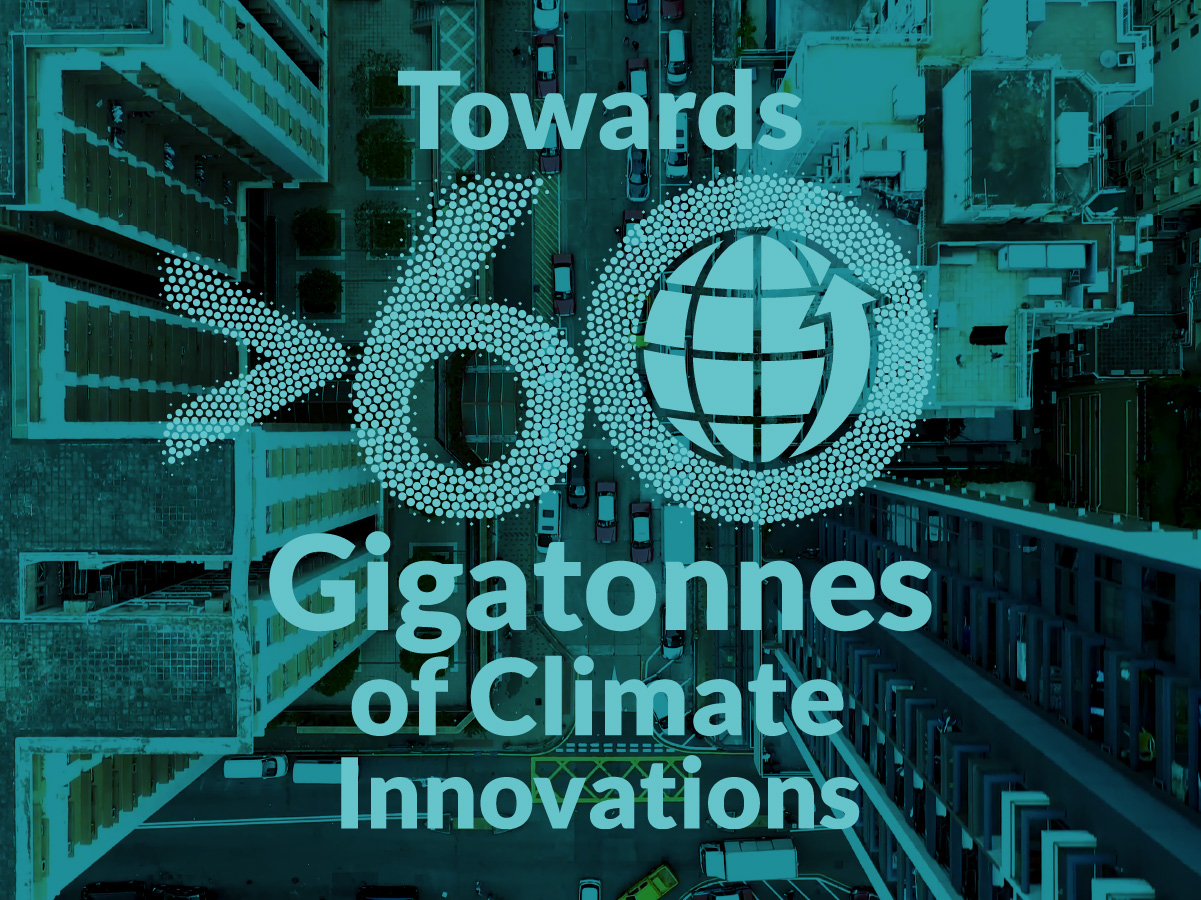Nominated innovations
1000 innovative clean energy solutions and > 150 framework enablers with the potential to deliver more than twelve gigatonnes of avoided emissions by 2030
These assessments are based on a basic avoided emission assessment. The overall concept of avoided emissions is that a solution (product or service) enables the same function to be performed with significantly less GHG emissions. The method of measuring avoided emissions, is to compare a baseline scenario without the enabling solution, with a scenario using the enabling solution; whereby the baseline represents the ‘business as usual’ (BAU) scenario.
These assessments are based on the framework document: The Avoided Emissions Framework (AEF) from September 2020

Solar Lake
H2O wrote: Using water harvesting methods to create an artificial lake and facilitating the distribution of water to nearby farms and communities through the use of solar pv pumps.. Source: EIT Climate KIC's Climathon
Sudan

H2O
Solar Lake
H2O wrote: Using water harvesting methods to create an artificial lake and facilitating the distribution of water to nearby farms and communities through the use of solar pv pumps.. Source: EIT Climate KIC's Climathon
Currently unavailable

Sustainable Passive Cooling System
Passive Cooling Team wrote: Creating a system that cools the house both naturally and mechanically by using passive cooling techniques (architectural building techniques such as cross ventilation, building orientation, stack ventilation, etc. ) and natural techniques for cooling (wind catchers, court yard effect, evaporative cooling, etc), and materials to achieve sustainable and efficient energy consumption... Source: EIT Climate KIC's Climathon
Sudan

Passive Cooling Team
Sustainable Passive Cooling System
Passive Cooling Team wrote: Creating a system that cools the house both naturally and mechanically by using passive cooling techniques (architectural building techniques such as cross ventilation, building orientation, stack ventilation, etc. ) and natural techniques for cooling (wind catchers, court yard effect, evaporative cooling, etc), and materials to achieve sustainable and efficient energy consumption... Source: EIT Climate KIC's Climathon
Currently unavailable

Sustainable kitchens
Environmentally fella wrote: Sustainable kitchens have a solar cooker, a solar heater for water as well as a solar dryer for fruits and vegetables. These devices are environmentally friendly because of their use of renewable energy, whereby they convert solar energy into heat, as well as being relatively affordable, another plus is that this kitchen employs a simple technology that can be used in refugee camps, in addition to it's variable sizes. It can also assist in creating extra income resources through the production and selling of dried foods. Part of our solution also involves carrying out awareness campaigns for citizens on how to use these kitchens and on environmental conservation... Source: EIT Climate KIC's Climathon
Sudan

Environmentally fella
Sustainable kitchens
Environmentally fella wrote: Sustainable kitchens have a solar cooker, a solar heater for water as well as a solar dryer for fruits and vegetables. These devices are environmentally friendly because of their use of renewable energy, whereby they convert solar energy into heat, as well as being relatively affordable, another plus is that this kitchen employs a simple technology that can be used in refugee camps, in addition to it's variable sizes. It can also assist in creating extra income resources through the production and selling of dried foods. Part of our solution also involves carrying out awareness campaigns for citizens on how to use these kitchens and on environmental conservation... Source: EIT Climate KIC's Climathon
Currently unavailable

Green Urban Design
GUD wrote: Our solution is composed of two parts, first a shed that is made of timber frames and climbing ivy trees, every unit is composed of five frames, with every unit being positioned 10 meters away from the next one. This part of our solution provides shade and decreases co2 due to the ivy presence. The second part of the solution constitutes of walls that are made of mud and are 9 meters long , 3-2 meters wide, these walls contain green panels, small fans with filters, it also contains fenestrations of variable sizes, the side that is facing wind is wider than the opposite side. These fenestrationcool the air by blocking wind movement and creating counter currents that are cooler and more purified... Source: EIT Climate KIC's Climathon
Sudan

GUD
Green Urban Design
GUD wrote: Our solution is composed of two parts, first a shed that is made of timber frames and climbing ivy trees, every unit is composed of five frames, with every unit being positioned 10 meters away from the next one. This part of our solution provides shade and decreases co2 due to the ivy presence. The second part of the solution constitutes of walls that are made of mud and are 9 meters long , 3-2 meters wide, these walls contain green panels, small fans with filters, it also contains fenestrations of variable sizes, the side that is facing wind is wider than the opposite side. These fenestrationcool the air by blocking wind movement and creating counter currents that are cooler and more purified... Source: EIT Climate KIC's Climathon
Currently unavailable

Regreening the Desert Training Centre
Regenerative Agriculture Sudan wrote: A training and demonstration site that teaches herding communities and individuals how to produce pastures from desert land using only their livestock and rain. This process of regreening the desert was pioneered by allan savory and is known as holistic planned grazing. It fights desertification all the while sequestering massive amounts of co2. The training centre will seek to 1) spread the practice of these sustainable grazing methods, 2) incubate projects implementing these methods, and 3) provide clients with a promising export market for livestock products abroad, where climate-friendly meat and produce are quickly becoming a trend... Source: EIT Climate KIC's Climathon
Sudan

Regenerative Agriculture Sudan
Regreening the Desert Training Centre
Regenerative Agriculture Sudan wrote: A training and demonstration site that teaches herding communities and individuals how to produce pastures from desert land using only their livestock and rain. This process of regreening the desert was pioneered by allan savory and is known as holistic planned grazing. It fights desertification all the while sequestering massive amounts of co2. The training centre will seek to 1) spread the practice of these sustainable grazing methods, 2) incubate projects implementing these methods, and 3) provide clients with a promising export market for livestock products abroad, where climate-friendly meat and produce are quickly becoming a trend... Source: EIT Climate KIC's Climathon
Currently unavailable

Mangrove: Help Earth Breathe
Mangrove Team wrote: Our solution is divided into two parts, the first part includes the planting of mangrove forests along the red sea coastline that is 760 kilometer long, these forests will have an enormous positive impact in absorbing co2 emissions, these forests will also serve in marine conservation. The second part of our solution is a project that will assist in the funding of the mangrove forests planting as well as spreading awareness concerning environmental challenges, ; this will be accomplished by the establishment of a factory that manufactures biodegradable shopping bags that will have also tags that spreads information regarding the environment... Source: EIT Climate KIC's Climathon
Sudan

Mangrove Team
Mangrove: Help Earth Breathe
Mangrove Team wrote: Our solution is divided into two parts, the first part includes the planting of mangrove forests along the red sea coastline that is 760 kilometer long, these forests will have an enormous positive impact in absorbing co2 emissions, these forests will also serve in marine conservation. The second part of our solution is a project that will assist in the funding of the mangrove forests planting as well as spreading awareness concerning environmental challenges, ; this will be accomplished by the establishment of a factory that manufactures biodegradable shopping bags that will have also tags that spreads information regarding the environment... Source: EIT Climate KIC's Climathon
Currently unavailable

AM Group
AM Group wrote: Developed a solar panel with a built in machine that rotates in the position of the sun light for maximum efficiency of energy intake. This is executed with the use of sensors... Source: EIT Climate KIC's ClimateLaunchPad
Suriname

AM Group
AM Group
AM Group wrote: Developed a solar panel with a built in machine that rotates in the position of the sun light for maximum efficiency of energy intake. This is executed with the use of sensors... Source: EIT Climate KIC's ClimateLaunchPad
Currently unavailable

Creative Recycling Solutions
Creative Recycling Solutions wrote: Creative recycling solutions is a social enterprise that is focused on upcycling used tires in the production of indoor and outdoor home and office furniture... Source: EIT Climate KIC's ClimateLaunchPad
Suriname

Creative Recycling Solutions
Creative Recycling Solutions
Creative Recycling Solutions wrote: Creative recycling solutions is a social enterprise that is focused on upcycling used tires in the production of indoor and outdoor home and office furniture... Source: EIT Climate KIC's ClimateLaunchPad
Currently unavailable

Organic Rankine Cycle turbine
Low-temperature heat can be captured and converted into electricity through the Organic Rankine Cycle (ORC) system. Againity takes advantage of low-temperature heat down to 90 degrees and can perform with systems in the range of 50-2500 kW energy production. The modularity of the Againity solution means they can be combined and scaled. Automation steers the system but can also be remotely controlled. The intended market is for heat sources from water boilers, treatment plants, or industrial processes.
Sweden
≈1

Againity AB
Organic Rankine Cycle turbine
Low-temperature heat can be captured and converted into electricity through the Organic Rankine Cycle (ORC) system. Againity takes advantage of low-temperature heat down to 90 degrees and can perform with systems in the range of 50-2500 kW energy production. The modularity of the Againity solution means they can be combined and scaled. Automation steers the system but can also be remotely controlled. The intended market is for heat sources from water boilers, treatment plants, or industrial processes.
≈1Mt CO2e/year

Algae based solar efficiency enhancing material
Through the extraction of nanoporous material from algae, a material with unique light altering, absorbing, and releasing properties can be created. It is useful in a wide variety of industries, such as cosmetics and biomaterials. Of potential interest from a perspective of avoided emissions, is that the material has been shown to be able to increase the efficiency of solar panels and cells (PV) both in lab and in field. The coating can be used on solar cells to improve efficiency by 4-5 % depending on the installation scale.
Sweden
≈1

Swedish Algae Factory AB
Algae based solar efficiency enhancing material
Through the extraction of nanoporous material from algae, a material with unique light altering, absorbing, and releasing properties can be created. It is useful in a wide variety of industries, such as cosmetics and biomaterials. Of potential interest from a perspective of avoided emissions, is that the material has been shown to be able to increase the efficiency of solar panels and cells (PV) both in lab and in field. The coating can be used on solar cells to improve efficiency by 4-5 % depending on the installation scale.
≈1Mt CO2e/year